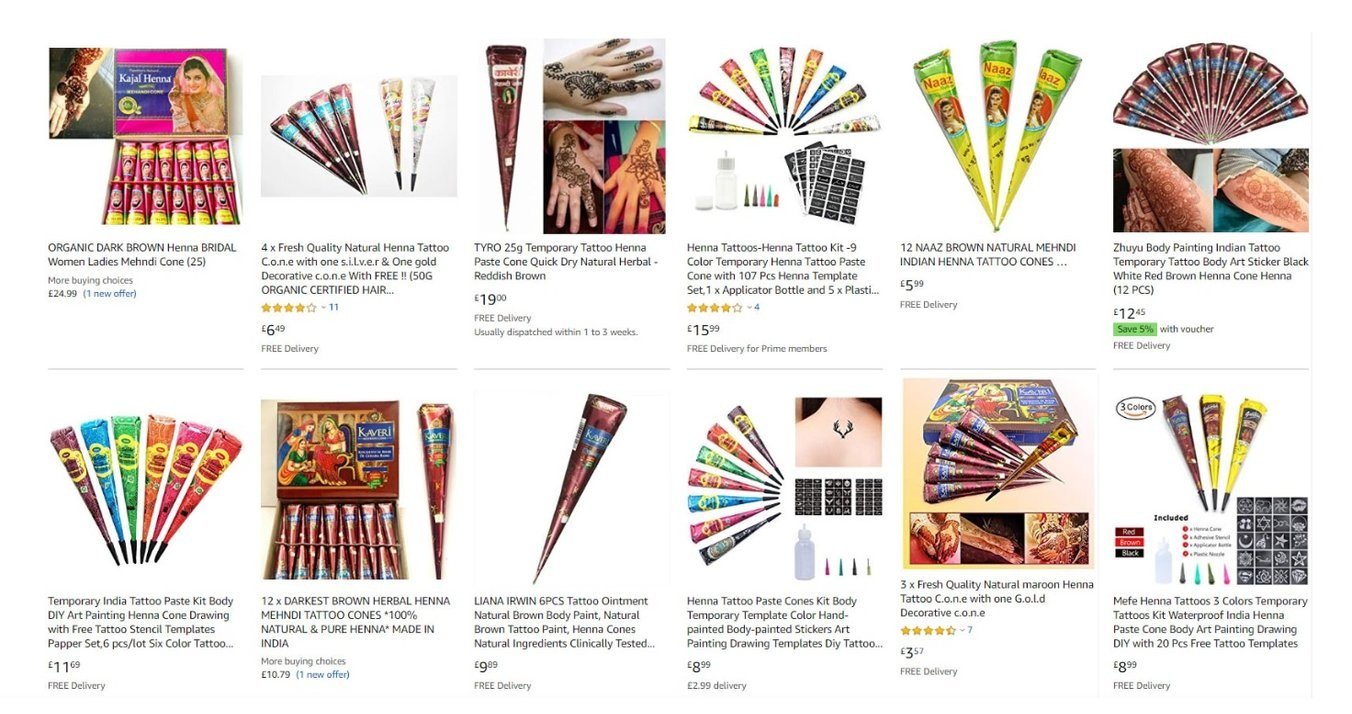Natural Henna, Black Henna? Safety Information
Fake Henna Is Dangerous!
Natural henna takes time and attention to get right. Unfortunately in our instant gratification society, shortcuts have been created to make this process faster and more foolproof. However, these shortcuts include harmful dyes and preservatives and while these mystery synthetic additives do create darker, longer lasting stains, they have also caused skin irritation, rashes, and even chemical burns and liver damage. Never risk your health for the sake of ‘fast henna’ - learn how to spot the fakers and only use natural henna! Pre-made henna cones available on Amazon, eBay, the corner grocery store or health food store are almost always fake henna, using the hair dye PPD or other dangerous ingredients to create fast and colourful stains.
Quite often you will see an artist offering Black Henna. This is NOT henna. Please, never get henna from someone offering instant henna, black henna, or any other colours. Even if the cones say “organic” or “natural” on them: if they are stored at room temperature and give you a dark stain within minutes, they contain the harmful dye PPD and can cause rashes, chemical burns and sensitivities. A quick google search should be enough to convince you to use natural henna, but if the photos of scarring and rashes aren’t enough, please read this safety notice from the Marrakech Henna Art Cafe.
Popular fake henna brands are: Golecha/Mirchi, Neeta, Neha, Surya, Kaveri, and Shakeel Bhai Mehndi. These are often sold with marketing like “pure”, “no chemicals”, “all natural”, “no PPD”, but the bottom line is that this is unregulated and they can write whatever they want on their cones. Even if these cones truly do not have PPD, if they are sold at room temperature they are not natural henna. Many cones on Amazon are even marketed for use on your face, to make cute freckles or to tint your eyebrows. Please do not be tricked into thinking this is safe to do with fake henna.
This is an assortment of what will show up if you search for henna cones on Amazon. Every one of these are fake henna and they are NOT safe.
In Canada and the USA, PPD is a restricted ingredient and must not be used in cosmetic applications where the dye will touch the skin. You can read the Government of Canada’s warning about black henna here, and read this news article about a Health Canada seizure of over 20,000 henna cones in 2018 after reports of rashes and chemical burns.
Learn How To Spot Natural Henna
Ask the henna artist if they make their own paste. Most artists who use natural henna will be excited that you asked and will gladly tell you what they use in their paste. Some artists may also purchase their henna from other reputable henna artists, but they will still be happy to tell you their ingredients. If you would like to do henna yourself, you must purchase henna cones from a reputable seller who discloses their ingredients, preferably a small business owner like Henna Art Canada (use my discount code HennaMe) or Henna Guru in the USA. Natural henna must stay frozen until use, so henna purchased online will be shipped using an expedited service for optimum freshness.
Common ingredients in henna paste include one or two types of henna powder (often Rajasthani and/or Jamila), sugar, a liquid like water, tea, lemon or apple juice, and an essential oil like lavender, tea tree oil, cajeput or neroli.
Jagua is another plant-based natural dye that stains your skin a blueish-black or grey colour. It comes from the Genipa Americana plant in central america and is typically applied as a gel, or can also be mixed with henna to create darker hues. This should not be confused with black henna and will be clearly communicated by the artist!
If you would like to learn to mix your own henna paste, you also must start out with body-art quality (BAQ) henna powder. It can be purchased from the retailers mentioned above as well. Typically, henna powder found at the corner market, a health food store, Amazon or eBay will be stale or can contain other additives. High quality henna will include a harvest date and it is recommend you use henna within 2 years of this date.
Natural henna must stay in contact with your skin for 4-6 hours to produce a deep stain, and the colour will always start out a light orange or brown colour and darken to a reddish mahogany after 2 days.
natural henna stain progression, over 3 days, from orange to dark mahogany
Your henna artist will give you instructions on how to care for your henna stain. If they tell you that you can wash it off, that’s a red flag that it is fake henna!
Natural Henna Care Instructions:
1) Keep it On! 4-6 hours; longer is better!
2) Keep it Warm!
3) Keep it Dry! Scrape the henna paste off gently; don’t rinse. Try to avoid washing the area for 12 hours after paste removal.
4) Keep it Moisturized! Use a balm or lotion to keep the area well-hydrated.
With a little bit of mindfulness, natural henna produces stunningly beautiful results without any need for dangerous ingredients. It’s unfortunate that we need to be so wary of artists using fake and dangerous henna products but if we work together to spread the word, more people will switch to safe & natural henna.
Studio Stiina is available for henna appointments in Princeton, BC and in the summer you can find her henna booth at the Community Markets on Saturdays in the downtown square (across from the post office on Bridge Street).





